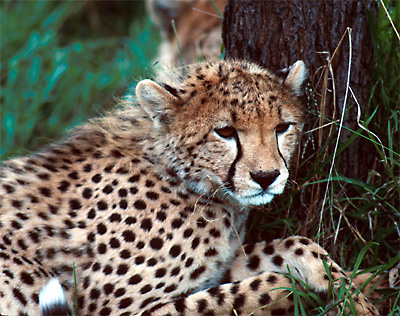The only cat that cannot completely retract its claws.
 The Cheetah (Acinonyx jubatus) is an atypical member of the cat family (Felidae) that hunts by sight and speed rather than by stealth. It is the fastest of all terrestrial animals and can reach speeds of over 110 km/h in short bursts.
The Cheetah (Acinonyx jubatus) is an atypical member of the cat family (Felidae) that hunts by sight and speed rather than by stealth. It is the fastest of all terrestrial animals and can reach speeds of over 110 km/h in short bursts.The cheetah's body is svelte and muscular, though it seems slender and almost fragile in build. Its chest is deep and its waist narrow. It has a small head and short muzzle, high-placed eyes, large nostrils, and small round ears. The fur of the cheetah is fauve yellow with round black spots and black tear lines on the sides of the muzzle. The adult animal weighs from 39 to 65 kg. Its total body length is from 112 to 135 cm, while the tail can measure up to 84 cm.
The genus name, Acinonyx, means "no-move-claw" in Greek, while the species name, jubatus, means "maned" in Latin, a reference to the mane found in Cheetah cubs. It is the only cat that cannot completely retract its claws. Even when retracted, the claws remain visible and are used for grip during the cheetah's acceleration and maneuvering.
The English word "cheetah" comes from Hindi chiitaa, which is perhaps derived from Sanskrit chitraka, meaning "the spotted one". Other major European languages use variants of the medieval Latin gattus pardus, meaning "cat-leopard": French guépard; Italian ghepardo; Spanish guepardo; and German Gepard.
Technorati Tags: cats
















0 Comments:
Post a Comment
<< Home